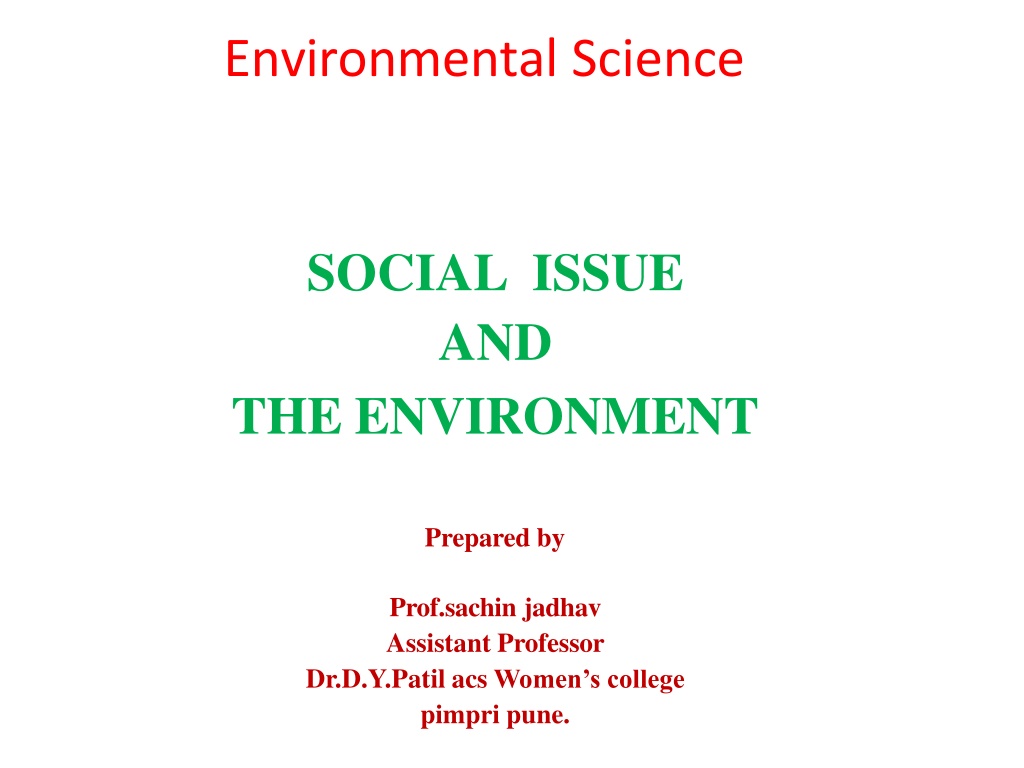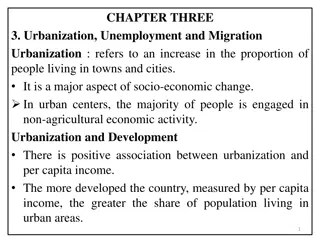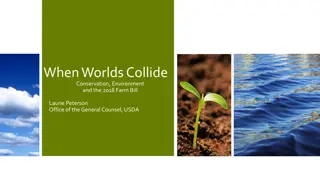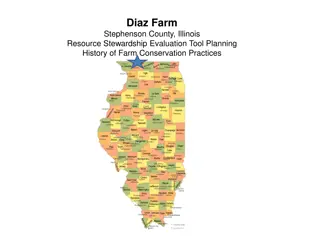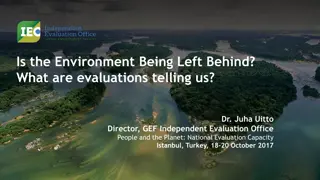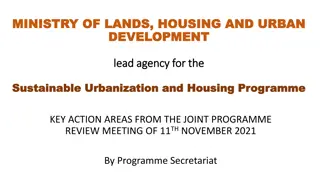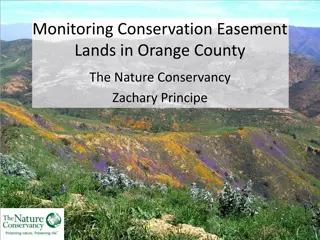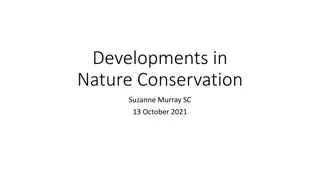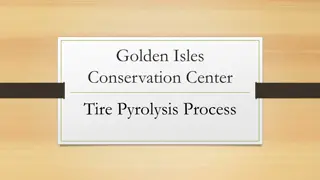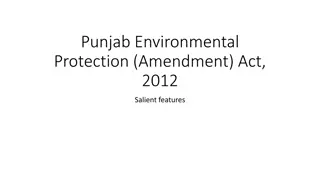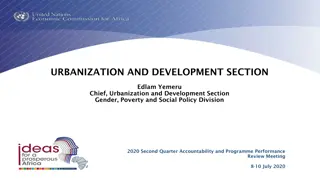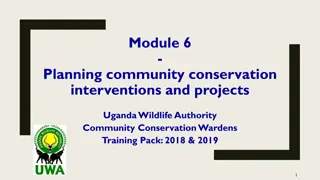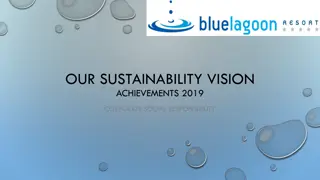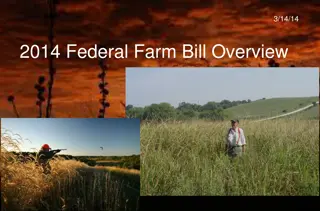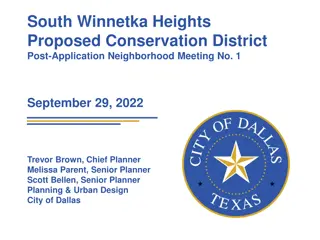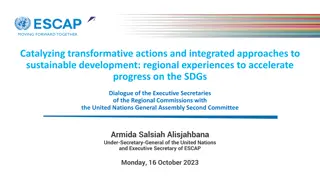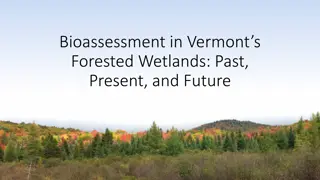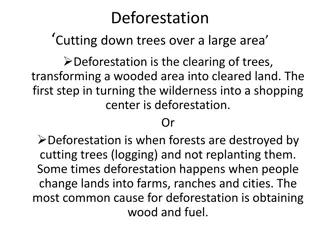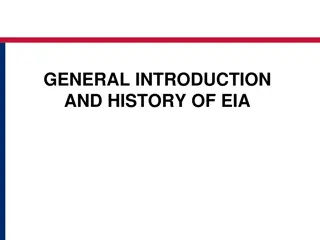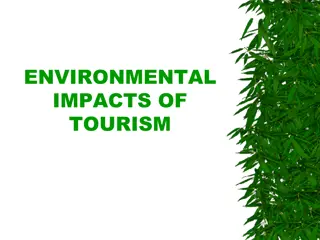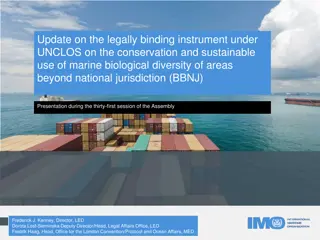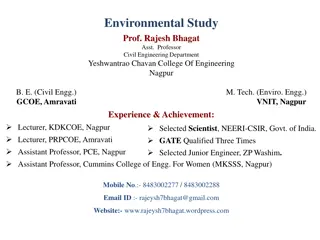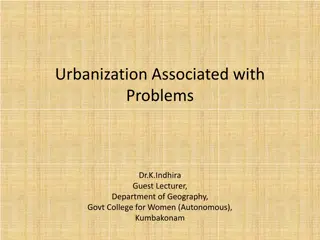Understanding Sustainable Development and Urbanization for Environmental Conservation
Sustainable development aims at optimizing natural resource use, reducing wastage, minimizing pollution, and maximizing productivity for inter-generational and intra-generational equity. Urbanization poses challenges like inadequate housing, water, and energy, with solutions such as solar energy and rainwater harvesting. Water conservation methods like watershed management and rainwater harvesting are vital to meet growing water demands and safeguard underground water sources amidst urbanization.
- Sustainable Development
- Urbanization
- Water Conservation
- Environmental Conservation
- Rainwater Harvesting
Download Presentation

Please find below an Image/Link to download the presentation.
The content on the website is provided AS IS for your information and personal use only. It may not be sold, licensed, or shared on other websites without obtaining consent from the author. Download presentation by click this link. If you encounter any issues during the download, it is possible that the publisher has removed the file from their server.
E N D
Presentation Transcript
Environmental Science SOCIAL ISSUE AND THE ENVIRONMENT Prepared by Prof.sachin jadhav Assistant Professor Dr.D.Y.Patil acs Women s college pimpri pune.
SUSTAINABLE DEVELOPMENT Sustainability between humans and resources they depend on for all their development activities. Objective: Optimum use of natural resources with Reusability Min.Wastage Least pollution Max.Productivity Types Inter-generational equity Intra-generational equity means relationship
URBANIZATION AND SUSTAINABLE DEVELOPMENT Urbanization Movement of human population from ruralto urban areas in need of education, health, communication and employment. Problem Increased urbanization leads to Inadequate Houses InadequateWater Inadequate Energy Solution Using Solar Energy for electricity problems Using Tube wells for water problems
WATER CONSERVATION Definition Process of Saving Water for Future Utilization Need for WaterConservation To meet the increasing demands of water. To recharge the underground water. To reduce the ground water contamination from the intrusion of saline water. To reduce the surface runoff loss. To increase hydrostatic pressure to stop land subsidence. Methods of WaterConservation Rain Water Harvesting Watershed Management
RAIN WATERHARVESTING Ground water plays a critical role in the urban environment. Urbanization strongly affects ground water recharge flow and quality thereby creating serious impact on urban infrastructure As urban dwellings go on increasing shrinkage of open land leads to continuous decline in ground water levels in many areas.
Rain water harvesting isessential Due to rapid urbanization infiltration of rain water into the soil has decreased drastically and recharging of ground water has diminished. Over exploitation of ground water resources has resulted in declined in water levels in most part of the country. To enhance availability of ground water at specific place and time. To improve the water quality in aquifers. To improve the vegetation cover.
BENEFITS OF RAIN WATERHARVESTING The ground water level will rise. Quality of water improves. Soil erosion will be reduced. Saving ground water . RAIN WATER HARVESTING TECHNIQUES: There are two main techniques of rain water harvestings. Storage of rainwater on surface for future use. Recharge of ground water.
Water shed management watershed is a basin like landform defined by peaks which are connected by ridges that descend into lower elevations and small valleys. It carries rainwater falling on it drop by drop and channels it into soil and streams flowing into large rivers. It involves management of land, water, energy and greenery integrating all the relevant approaches appropriate to socioeconomic background for a pragmatic development of a watershed.
Greening of the watershed through proper management of land, water and energy resource. The objectives of watershed management Conserving soil and water Improving the ability of land to hold water Rainwater harvesting and recharging Growing greenery trees, crops and grasses
RESETTLEMENTAND REHABILITATION Resettlement Relocation or displacement of human population Rehabilitation TREATMENT MAKING THE SYSTEM TO WORKAGAIN Repairing Damaged Infra Structures Providing Safe Land for Building Restore Social Services
ENVIRONMENTALETHICS Definition: Environmental ethics refers to the Issues. Principles. Guidelines. relating to human interactions with their Environment. Environmental Problems Acid Rain, b. Air Pollution, c. GlobalWarming, d. Hazardous Waste, a.
CLIMATE CHANGE Causes Uneven Heating Earth s Surface. Properties Air, Land andWater. Fossil Fuels Combustion. Green House Gases. Effects Affect Agriculture, Wind andOcean Current. Relocation of Birds, Animals andHumans. Acid Rain.
The greenhouse effect is a process by which radiant energy leaving a planetary surface is absorbed by some atmospheric gases, called greenhouse gases. They transfer this energy to other components of the atmosphere, and it is re- radiated in all directions, including back down towards the surface. This transfers energy to the surface and lower atmosphere, so the temperature there is higher than it would be if direct heating by solar radiation were the only warming mechanism.
Greenhouse gases By their percentage contribution to the greenhouse effect on Earth the four major gases are: water vapor, carbon dioxide, methane, ozone, 3 7% 36 70% 9 26% 4 9%
Global warming is the increase in the average temperature of Earth's near-surfaceair and oceans since the mid-20th century. Global surface temperature increased 0.74 0.18 C (1.33 0.32 F) during the 20th century. Most of the observed temperature increase since the middle of the 20th century has been caused by increasing concentrations of greenhouse gases, which result from human activity such as the burning of fossil fuel and deforestation. Global dimming, a result of increasing concentrations of atmospheric aerosols that block sunlight from reachingthe
ACID RAIN As the name suggests, acid rain is just rain which is acidic. The rain becomes acidic because of gases which dissolve in the rain water to form various acids. In general about 70 percent of acid rain comes from sulphur dioxide (SO2), which dissolves into the water to form sulphuric acid. The rest comes from various oxides of nitrogen mainly NO2 and NO3, collectively called Nox, Oxides of carbon
CONTROLMETHODS The best approach to reduce acid rain is to reduce the amount of NOx ,SO2 and CO2 being released into the atmosphere. Fitting a catalytic converter to a car can reduce the emissions of NOx by up to 90 percent, but they are very expensive, and cause more carbon dioxide to bea released, which contributes to the greenhouse effect. Best option is not to burn fossil fuels, but to use alternative energy sources which are less polluting.
Formation of ozone in the atmosphere: Ozone absorbs uv radiations and is broken into atomic and molecular oxygen. O2 -- 2O O3 -- O +O2 The products formed combine again to form ozone O + O2 ---- O3 and hence a dynamic equilibrium is set up due to which the concentration of ozone in the atmosphere remains constant.
The ozone layer protects the earth from the harmful uv radiations. If the concentration of ozone is reduced (ozone depletion), the concentration of uv radiations reaching the earth increases. This leads to irritation of the eyes, skin cancer and damage to immune system in human beings. In agriculture it causes decrease in productivity.
Causes of ozone depletion Chlorofluorocarbons (CFCs) are used as refrigerants,aerosols and as industrial solvents. CFCs are noncombustible and volatile. They reach the atmosphere and are broken down into chlorine free radicals byuv radiations. ill effects Due to ozone hole, the uv radiation increases causingeye infections, skin cancer in human beings and decrease in photosynthesis in plants. Control of ozone depletion: Ozone depletion can be controlled by using hydrochlorofluorocarbons and hydrofluoroalkanes in placeof CFCs. These contain more hydrogen in their molecule and undergo oxidation readily.
NUCLEAR ACCIDENTS AND NUCLEARHOLOCAUST Causes Trucks carrying radioactive waste Leakage in reactor vessel Explosion test underground Improper disposal Effects Nuclear radiation of Low Dose(100 250 rads) Fatigue, Vomitingand Loss of Hair Higher Dose(400-500 rads) Bone Marrow,Blood Cells, Cancer Very Higher Dose(10,000 rads) Heart, Brain and Cancer
WASTE LAND RECLAMATION( or RECOVERY) Types of Waste Lands Uncultivable WasteLands Cultivable WasteLands Causes of Waste Land Formation Over-exploitation of natural resources. Overgrazing, deforestation, soil erosion, water logging. Mining activities, growing demand for fuel, fodder, wood & food. Developmental activities dams, power projects. Objective (or) Need of Waste Land Reclamation Increasing population need Food, Land and Shelter Prevent Soil Erosion, Landslides and Drought Conserve Biological Resources and Natural Ecosystems Avoiding Over exploitation of natural resources
CONSUMERISM Purchasing and consumption of good products Objectives Improve Powers of Sellers and Buyers Good Relationship Sellers and Buyers Reuse and Recycle No Pollution After Sale Service Traditionally favourable rights of sellers: The right to introduce any product. The right to charge any price. The right to spend any amount to promote theirproduct. The fight to use incentives to promote their products.
Traditional buyer rights: The right to buy or not to buy. The right to expect a product to be safe. The right to expect the product to perform asclaimed. Waste Products Sources of wastes: agricultural, mining, industrial and municipal wastes. Examples for waste products: glass, papers, garbage, plastics, soft drink cans, metals,food wastes. Automobile wastes, deadanimals E waste (Electronic and factory wastes) Electronic equipments like computers, printers, mobilephones, xerox ,machines, calculators, etc.,
Effects ofwastes From chemical industries- Dangerous to human life. Dumped wastes Degrade soil and make unfit for irrigation. E-waste toxic- In computers, lead is present in monitors, cadmium in chips and cathode ray tube, PVC in cables. All these causecancer. Plastics nonbiodegradable - their combustion produces toxic gases. Factors affecting consumerism & generation of wastes People over population Consumption Over - population
ENVIRONMENTAL PROTECTIONACT Constitution of India has a number of provisions demarcating the responsibility of the central and state government towards Environmental Protection. According to section 2(a) of Environmental Protection Act (1986), .Environment.includes, (i) Water, air and land, (ii)The interrelationship which exists among and between, (a) Water, air and land and (b)Human beings, other living creatures, plants, micro-organisms and property.
Various statues / legislations are enacted in India exclusively for Environment Protection are, The Water (Prevention and Control of Pollution) Act,1974 The Air (Prevention and Control ofPollution) Act, 1981 The Environmental Protection Act,1986 The Forest Conservation Act,1980 The Wild Life Protection Act,1972
AIR (PREVENTION AND CONTROLOF POLLUTION) ACT, 1981 The objective of the Act is to provide for the prevention, control and abatement of air pollution Functions of Central Board Advice to central government on any matter related to air quality To execute nation wide awareness programme To provide technical assistance and guidance to state boards Collect technical and statistical data to prepare manuals, code, and guide related to air. To lay down standards for the quality of air.
Penalty for Contravention of Certain Provision of theAct This act shall be punishable with imprisonment for a term which may extend to 3 month or with a fine extend to Rs. 10,000/- or with both. Both companies and government departments are also prosecuted under the AirAct. No court shall take cognizance of any offence except on a complaint made by any person who has given notice of not less than 60 days, in the manner prescribed of the alleged offenceand his intention to make a complaint to the board.
ENVIRONMENTAL PROTECTION ACT, 1986 (EPA) Environment. includes water, air and land and the interrelationship which exists among and between them and human beings, other living creature, plants, micro-organisms and property. Environmental Pollutant. means any solid, liquid or gaseous substances present in such concentration as may be or tend to be injurious to environment. Hazardous Substance. means any substance or preparation which by reason of its chemical or physico-chemical properties or handling is liable to cause harm to human beings, other living creatures, plants, micro-organisms, property of the environment.
RULES TO REGULATE ENVIRONMENTAL POLLUTION The standards of quality of air, water or soil for various areas and purposes The maximum allowable limits of concentration of various environmental pollutants (including noise) for differentareas The procedures and safeguards for the handling of hazardous substances The prohibition and restrictions on the handling ofhazardous substances in different areas The prohibition and restriction on the location of industries and the carrying on process and operations in different areas The procedures and safeguards for the prevention of accidents which may cause environmental pollution and for providing for remedial measures for such accidents.
THE FORESTS CONSERVATION ACT,1980 It is well known that breaking up the soil or clearing of the forest land affects seriously reforestation or regeneration of forests and therefore, such breaking up of soil can only be permitted after taking into consideration all aspects of the question, the over all advantages and disadvantages to the economy of the country. Environmental conditions, ecological imbalance that is likely to occur, its effects on the flora and the fauna in the area, etc., it was therefore thought that the entire control of the forest areas
That any reserved forest (within the meaning of the expression "reserved forest" in any law for the time being in force in that State) or any portion thereof, shall cease to be reserved; That any forest land or any portion thereof may be used for any non-forest purpose; That any forest land or any portion thereof may be cleared of trees which have grown naturally in that land or portion, for the purpose of using it for reforestation.
WILD LIFE PROTECTIONACT The Central Government shall constitute a body to be known as the Central Zoo Authority to exercise the powers conferred on, and to perform the functions assigned to it under thisAct. Functions of theAuthority The Authority shall perform the following functions, namely: (a)Specify the minimum standards for housing, upkeep and veterinary care of the animals kept in a zoo. (b)Evaluate and assess the functioning of zoos with respect to the standards or the norms as may be prescribed.
(c)Recognise or derecognize zoos; (d)Identify endangered species of wild animals for purposes of captive breeding and assigning responsibility in this regard to a zoo. (e)Co-ordinate the acquisition, exchange and loaning of animals for breeding purposes. (f)Ensure maintenance of stud books of endangered species of wild animals breed in captivity.
Bhopal disaster The Bhopal disaster (also referred to as the Bhopal gas tragedy) is the world's worst industrial catastrophe. It occurred on the night of December 2 3, 1984 at the Union Carbide India Limited (UCIL) pesticide plant in Bhopal, Madhya Pradesh, India. A leak of methyl isocyanate (MIC) gas and other chemicals from the plant resulted in the exposure of several thousands of people.
During the night of December 23, 1984, water entered a tank containing 42 tons of MIC. The resulting exothermic reaction increased the temperature inside the tank to over 200 C (392 F) and raised the pressure. The tank vented releasing toxic gases into the atmosphere. The gases were blown by northwesterly winds over Bhopal.
Factors leading to the magnitude of the gas leak include: Storing MIC in large tanks and filling beyond recommended levels. Poor maintenance after the plant ceased MIC production at the end of 1984. Failure of several safety systems (due to poor maintenance). Safety systems being switched off to save money including the MIC tank refrigeration system which could have mitigated the disaster severity.
